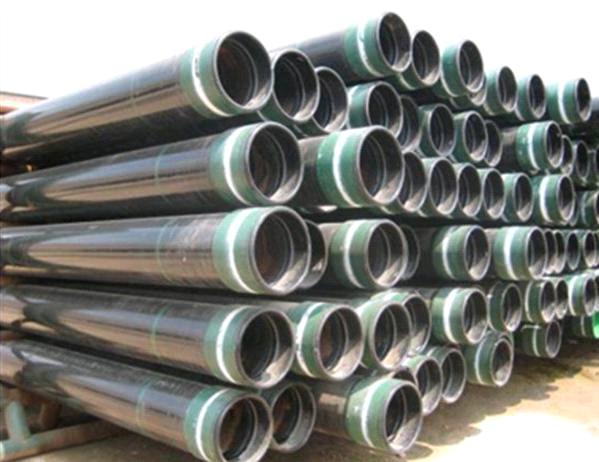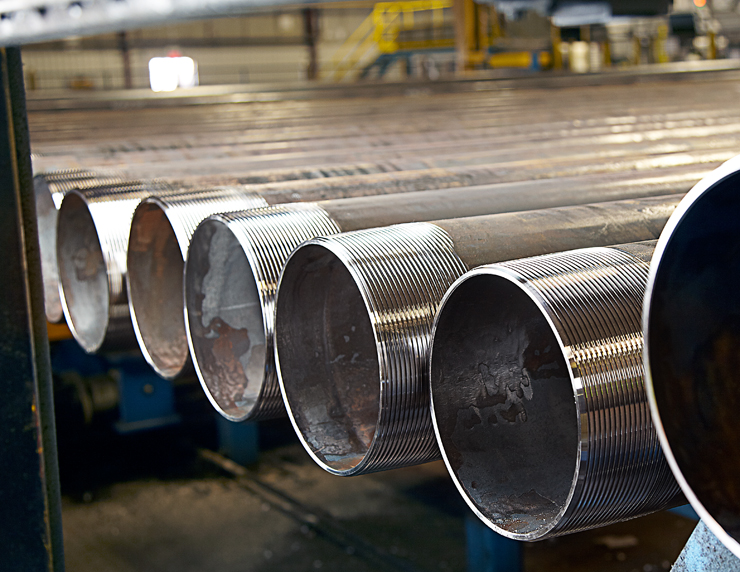There are two types of oil-field casing manufactured today: seamless and welded. Each has specific advantages and disadvantages.
Seamless Casing

Seamless casing accounts for the greatest amount of oil-field casing in use today. Each joint is manufactured in a pipe mill from a solid cylindrical piece of steel, called a billet. The billet is sized so that its volume is equal to that of the joint of pipe that will be made from it. The manufacturing process involves
• Heating the billet to a high temperature.
• Penetrating the solid billet through its length with a mandrel such that it forms a hollow cylinder.
• Sizing the hollow billet with rollers and internal mandrels.
• Heat treating the resulting tube.
• Final sizing and straightening.
The threads may be cut on the joints by the manufacturer or the plain-end tubes may be sent or sold to other companies for threading. The most difficult aspect of the manufacture of seamless casing is that of obtaining a uniform wall thickness. For obvious reasons, it is important that the inside of the pipe is concentric with the outside. Most steel companies today are very good at this. A small few are not, and that is one reason that API and ISO standards of quality were adopted. Current standards allow a 12.5% variation in wall thickness for seamless casing. The straightening process at the mill affects the strength of the casing. In some cases, it is done with rollers when the pipe is cool and other cases when the pipe is still hot. Seamless casing has its advantages and also a few disadvantages.
• Advantages of Seamless Casing.
• No seams to fail.
• No circumferential variation of physical properties.
• Disadvantages of Seamless Casing.
• Variations in wall thickness.
• More expensive and difficult manufacturing process.
Welded Casing

The manufacturing process for welded casing is quite different from that of seamless casing. The process also starts with a heated steel slab that is rectangular in shape rather than cylindrical. One process uses a relatively small slab that is rolled into a flat plate and trimmed to size for a single joint of pipe. It is then rolled into the shape of a tube and the two edges are electrically flash welded together to form a single tube. Another process uses electric resistance welding (ERW) as a continuous process on a long ribbon of steel from a large coil. The first stage in this process is a milling line in the steel mill:
• A large heated slab is rolled into a long flat plate or ribbon of uniform thickness.
• Plate is rolled into a coil at the end of the milling line.
The large coils of steel “ribbon” are then sent to the second stage of the process, called a forming line.
• Steel is rolled off the coil and the thickness is sized.
• Width is sized to give the proper diameter tube.
• Sized steel ribbon is formed into a tubular shape with rollers.
• Seam is fused using electric induction current.
• Welding flash is removed.
• Weld is given an ultrasonic inspection.
• Seam is heat treated to normalize.
• Tube is cooled.
• Tube is externally sized with rollers.
• Full body of pipe is ultrasonically inspected.
• Tube is cut into desired lengths.
• Individual tubes are straightened with rollers.
This is the same process by which coiled tubing is manufactured, except coiled tubing is rolled onto coils at the end of the process instead of being cut into joints. Note that, in the welding process, no filler material is used; it is solely a matter of heat and fusion of the edges.
Welded casing has been available for many years, but there was an initial reluctance by many to use it because of the welding process. Welding has always been a matter of quality control in all applications, and a poor-quality weld can lead to serious failure. Today, it is both widely accepted and widely used for almost all applications except highpressure and/or high-temperature applications. It is not used in the higher yield strength grades of casing.
• Advantages of Welded Casing.
• Uniform wall thickness.
• Less expensive than seamless.
• Easier manufacturing process.
• Casing is inspected during manufacturing process (ERW) and the defective sections removed.
• Uniform wall thickness is very important in some applications, such as the newer expandable casing.
• Disadvantages of Welded Casing
• High temperatures of welding process.
• Possible variation of material properties due to welding.
• Possible faulty welds.
• Possible susceptibility to failure in weld.
Welded casing has been used for many years now. Many of the so-called disadvantages are perhaps more a matter of perception than actuality.
Strength Treatment of Casing
When a cast billet or slab is formed into a tube it is done at quite high temperature. The deformation that takes place in the forming process is in a plastic or viscoplastic regime of behavior for the steel. As it cools its crystalline structure begins to form. Once the crystalline structure forms or begins to form, any additional plastic deformation to which we subject the tube will change its properties. The change may be minor or significant, depending on the constituents of the steel, the amount of deformation, and the temperature. Heating a tube above certain temperatures and cooling slowly allows the crystals to form more uniformly with fewer structural imperfections, called dislocations, in the lattice structure. The properties of the steel can modified by the addition of certain constituents to the alloy and, to some extent, by controlling the cooling rate. One common process for enhancing the performance properties of casing is to heat the tube above a certain temperature then quickly cool it by spraying it withwater or some other cool fluid to change its properties, especially near the surface. This process is called quench and temper, or QT for short, and is an inexpensive alternative to adding more expensive alloys.
Some steels are said to get “stronger” when they are deformed plastically at ambient temperatures. This is part of the manufacturing process in some steels and is called cold working. Cold working typically increases the steel’s yield strength, however it does not, in general, increase the ultimate strength. Straightening casing joints in the latter stages of the manufacturing process can also have an effect on the properties of the tube depending on whether it is done at “cool” temperatures or “warm” temperatures.

%20(1).png)



